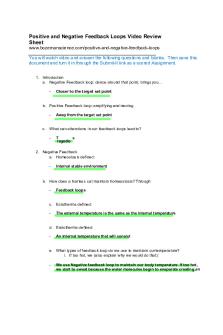Video Positive and Negative Feedback Loops Video Review Sheet 1 PDF

| Title | Video Positive and Negative Feedback Loops Video Review Sheet 1 |
|---|---|
| Author | Treva Hadden |
| Course | Human Biology Lab |
| Institution | Florida International University |
| Pages | 3 |
| File Size | 80.2 KB |
| File Type | |
| Total Downloads | 45 |
| Total Views | 136 |
Summary
Answers to video assignments...
Description
Positive and Negative Feedback Loops Video Review Sheet www.bozemanscience.com/positive-and-negative-feedback-loops You will watch video and answer the following questions and blanks. Then save this document and turn it in through the Submit-It link as a scored Assignment.
1. Introduction a. Negative Feedback loop: dance around that point, brings you…
ANSWER: Target set point b. Positive Feedback loop: amplifying and moving
ANSWER: Moving away from the target set point c. What can alterations in our feedback loops lead to?
ANSWER: Tragedy (i.e. diabetes) 2. Negative Feedback a. Homeostasis defined:
ANSWER: Internal stable environment b. How does a hairless cat maintain homeostasis? ANSWER: Through feedback loops c. Ectotherms defined: ANSWER: Internal and external temperature at the same time d. Endotherms defined: ANSWER: Constant internal temperature e. What types of feedback loop do we use to maintain our temperature? i. If too hot we (also explain why we would do that):
ANSWER: We use NEGATIVE feedback loops to maintain our temperature. When we get too hot, we sweat, and the water molecules create evaporative cooling. Additionally, we vasodilate (blood carried toward the surface of the skin) and through convection we’ll lose more of that heat to our environment. ii. If too cold we (again, explain why that behavior):
ANSWER: We get goosebumps when we get too cold. Goosebumps pull skin in and hold heat. Additionally, we vasoconstrict/shut off capillary shunts having less convection until the body hits that target set point.
3. Positive Feedback a. What plant hormone does ripe fruit give off?
ANSWER: Ethylene b. Why can one “bad apple” spoil a barrel?
ANSWER: Because of communication with the other apples via ethylene. c. How is fruit ripening an example of positive feedback? ANSWER: The first apple that ripens gives off ethylene to the next apples and so on and so forth (the process repeats itself). d. What is the example in humans?
ANSWER: Childbirth e. Positive feedback is not used for a long time, it is used when you
want to do something…. ANSWER: It is used to get things done really quickly. 4. Mistakes in Feedback Loops a. Besides being in your blood, where else could glucose go? (2x)
ANSWER: It could be stored in glycogen (liver) or can be taken in by cells (ATP). b. What two hormones help with blood glucose regulation:
ANSWER: Insulin and glucagon c. What organ and what other job does it have?
ANSWER: The pancreas – empties digestive enzymes into the small intestine and regulate the blood glucose levels. d. What are the two cells found in the pancreas and what does each do?
ANSWER: Alpha and Beta. Alpha cells create glucagon and frees up glucose to be used throughout the body. Beta cells triggers an influx of calcium and increases the amount of insulin it’s giving off. Insulin will be secreted, liver will store as glycogen, and the glucose level will go down. e. Why does the blood glucose levels usually rise three times per day?
ANSWER: To maintain a static position. f.
What else was rising at the same time?
ANSWER: Blood glucose and insulin were rising at the same time. g. What is wrong when you have type I diabetes?
ANSWER: The beta cells do not work (there is no insulin to secrete).
h. What is type II diabetes a result of usually? ANSWER: It is a result of lack of exercise, obesity, and too much glucose.
i. What pattern do you see with diabetes worldwide and why is that? ANSWER: The pattern comes in with diet. Our diets tend to be high in fats and sugars. It is tied to a mistake in feedback loops as well....
Similar Free PDFs

Kliptech Video Review
- 2 Pages

Video Review 3
- 2 Pages

L1 Video Review
- 2 Pages

review video pembelajaran
- 1 Pages

The Negative Effects of Video Games
- 16 Pages

Negative Feedback Amplifier
- 55 Pages

Libertà Negative E Positive
- 1 Pages

Berlin Wall Video Answer Sheet
- 1 Pages
Popular Institutions
- Tinajero National High School - Annex
- Politeknik Caltex Riau
- Yokohama City University
- SGT University
- University of Al-Qadisiyah
- Divine Word College of Vigan
- Techniek College Rotterdam
- Universidade de Santiago
- Universiti Teknologi MARA Cawangan Johor Kampus Pasir Gudang
- Poltekkes Kemenkes Yogyakarta
- Baguio City National High School
- Colegio san marcos
- preparatoria uno
- Centro de Bachillerato Tecnológico Industrial y de Servicios No. 107
- Dalian Maritime University
- Quang Trung Secondary School
- Colegio Tecnológico en Informática
- Corporación Regional de Educación Superior
- Grupo CEDVA
- Dar Al Uloom University
- Centro de Estudios Preuniversitarios de la Universidad Nacional de Ingeniería
- 上智大学
- Aakash International School, Nuna Majara
- San Felipe Neri Catholic School
- Kang Chiao International School - New Taipei City
- Misamis Occidental National High School
- Institución Educativa Escuela Normal Juan Ladrilleros
- Kolehiyo ng Pantukan
- Batanes State College
- Instituto Continental
- Sekolah Menengah Kejuruan Kesehatan Kaltara (Tarakan)
- Colegio de La Inmaculada Concepcion - Cebu







